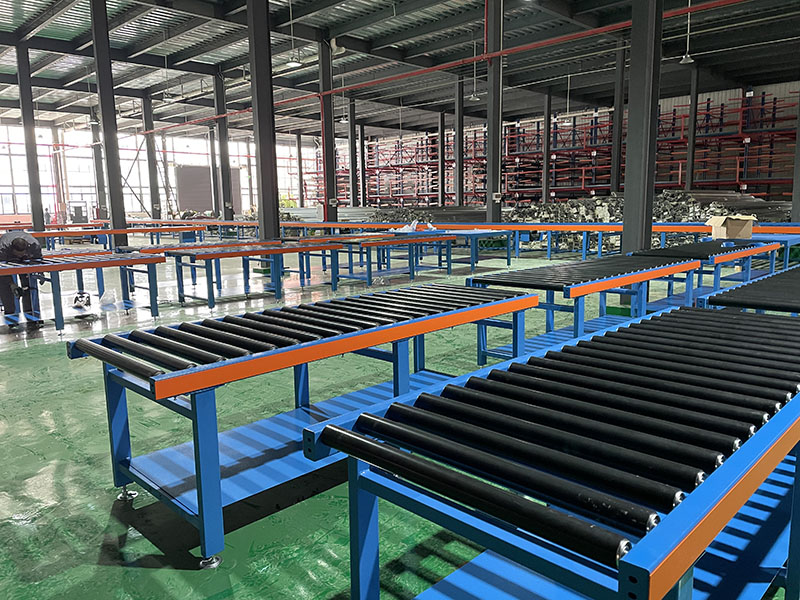When to use a gravity roller conveyor?
Gravity roller conveyors are available in different configurations but work on the same principle as other conveyors. Instead of using motor power to move the load, a gravity conveyor usually moves the load along a ramp or by a person pushing the load along a flat conveyor. Gravity roller conveyors transport products or work processes from one work area to another and are cost-effective and ergonomic for moving materials.
GCS conveyor roller manufacturers can supply you with galvanized, stainless steel, PVC, and high polymer polyethylene rollers. Most of these conveyor systems are available with roller diameters from 1.5" to 1.9". For extreme load applications, 2.5" and 3.5" diameters are available. We also have linear gravity roller conveyors, curved gravity roller conveyors, and telescopic portable roller conveyors. Different use scenarios and different materials to be transported can be accommodated. Gravity roller conveyors are a valuable tool when designing material handling solutions for your application.
We are the leading roller conveyor manufacturer. We can analyze your gravity roller conveyor requirements and configure the system for you. Other names include gravity roller conveyors, roller conveyor tables, or roller conveyor frames. We have even heard people ask for a "roller conveyor" even if there is no belt. All of these descriptions refer to a simple system, as shown in the diagram below. More detailed information on the types of roller conveyors can be found below.
Gravity roller conveyor. This is the most common type. It has no motor.
Gravity conveyor. Many people use this term for roller conveyors. But they do not have belts.
Power Roller Conveyor. These systems have rollers driven by a motor. There are two main styles, Non-drive roller conveyors and Drive roller conveyors. Follow the links to the pages dedicated to these two conveyor types.
Belt-driven roller conveyors are another option, where the roller is driven by a belt. These types of conveyors are more commonly found in curves.
Spool roller conveyors. Another variant of the belt-driven roller conveyor.
Heavy-duty roller conveyors. These are usually roller conveyors with a roller diameter of 2.5", 3.5" or larger. They are not very common as conveyors normally used for heavy loads have motors.
Components of the gravity roller conveyor
The gravity roller conveyor has no driving equipment, transmission equipment, or electric control equipment, and consists of only two major parts: the frame and the roller. The surface formed by several rollers or rollers placed between the structures can be made horizontal, relying on human power to push the goods for transport; it can also be made downward with a small inclination angle so that the goods rely on their gravity in the direction of transport to divide the force and transport themselves.
The rollers (usually made of steel) are supported by bearings (usually oil-sealed) and are mounted on a shaft (hexagonal or circular shaft). The shaft is contained within a formed or structurally punched frame by internal springs or retaining pins. Roller conveyors are suitable for heavier loads where permanent installation may be required. The size of the rollers and shafts depends on the intended application. Bespoke or standard legs are available in bolted or welded configurations at various heights.
The rollers used in gravity roller conveyors are the means of transporting products in most types of gravity conveying systems. They are available in many sizes, with a wide choice of bearings, fixtures, and shafts.
Characteristics of gravity roller conveyor
1. Easy and simple to install: the basic components will be installed before leaving the factory, basically no assembly is needed, it can be put together and used.
2. Meet transport needs: straight, turning, inclined and other delivery lines, can be formed according to the needs of various forms of the branch, merging, and other delivery lines and the delivery line is easy to close.
3. Simple and environmentally friendly packaging: usually in wooden boxes or cartons (small parcels).
4. Flexible application scenarios: can be used for express transport, car unloading, food processing, and other industries.
5. Low noise and high efficiency: not easy to produce noise when using, improving efficiency and save manpower and material resources.
6. Safe and low maintenance cost: the roller with RS sealed waterproof and dust-proof structure is easy to maintain and can even be maintenance-free.
We are professional, with excellent technology and service. We know how to make our conveyor roll move your business! Further, check www.gcsconveyor.com Email gcs@gcsconveyoer.com
GCS reserves the right to change dimensions and critical data at any time without any notice. Customers must ensure that they receive certified drawings from GCS prior to finalizing design details.
Post time: Jun-24-2022




